#la odisea de los rabadíes: el primer exilio hispano
Explore tagged Tumblr posts
Text
Related with the Rabadis chapter of the Al Andalus. Historical Figures, there's some books and historical novels about the topic. Two of them are mentioned in a a couple of articles about the Rabadis I posted and translated here on Tumblr (X) (x) if anyone wants to take a look.
The last two books are historical novels, from a saga, The Arrabal Lineage, whose second novel was published last year.
La Odisea de los Rabadíes: El primer exilio hispano (The Odyssey of the Rabadis: the first Hispanic exile) by Manuel Harazem
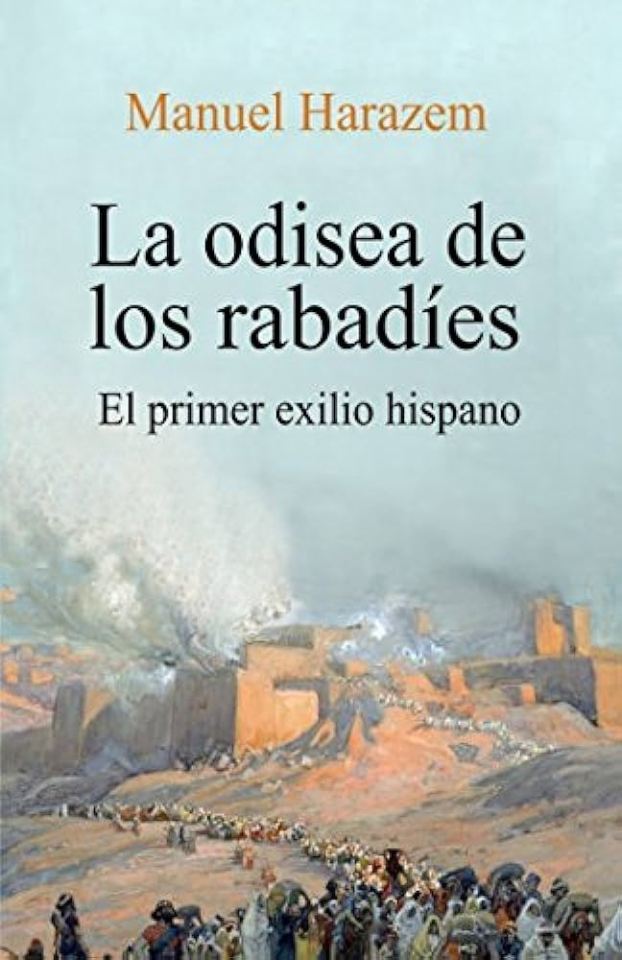
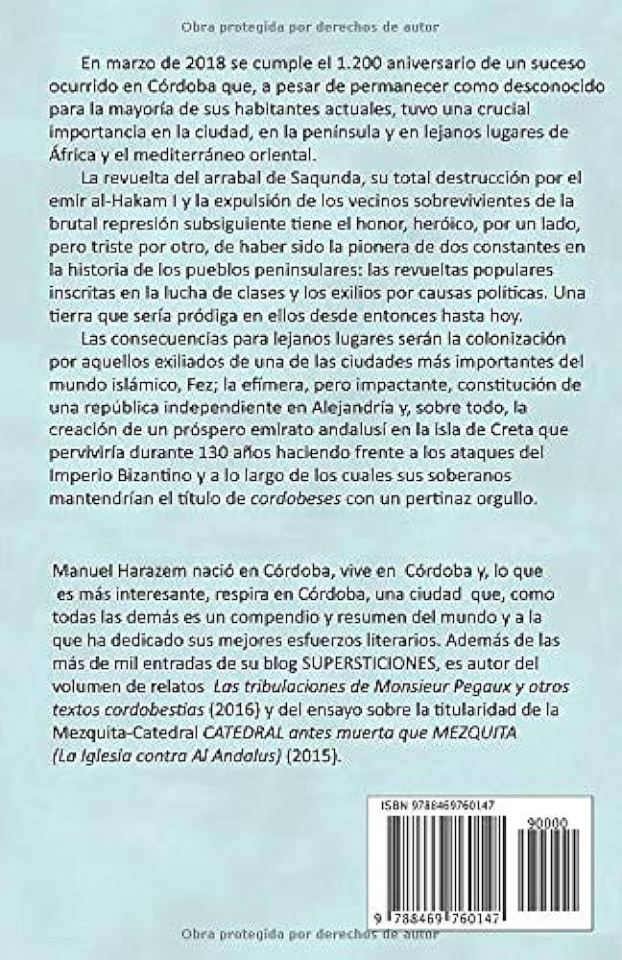
March 2018 marks the 1,200th anniversary of an event that occurred in Córdoba that, despite remaining unknown to the majority of its current inhabitants, had crucial importance in the city, on the peninsula and in distant places in Africa and the Eastern Mediterranean. The revolt of the Saqunda suburb, its total destruction by the emir al-Hakam I and the expulsion of the surviving residents of the subsequent brutal repression has the honor, heroic on the one hand, but sad on the other, of having been the pioneer of two constants in the history of the peninsular peoples: the popular revolts inscribed in the class struggle and the exiles for political reasons. This is the first popular revolt for socioeconomic reasons and the first exile for political reasons that we have documentary evidence in the history of the Iberian Peninsula, a land that would be lavish in them from then until today. The consequence for Córdoba will be that the southern bank of the Guadalquivir would never be historically urbanized again until today, turning it into a strange case of a large city located on the bank of a river and equipped with a magnificent bridge that did not take advantage of that circumstance to develop in parallel. The consequence for distant places will be the colonization by those exiles of one of the most important cities of the Islamic world, Fez, the ephemeral, but impactful, founding of an independent republic in Alexandria and above all the creation of a prosperous Andalusian emirate on the island. of Crete that would survive for 130 years, facing the attacks of the Byzantine Empire, and throughout which its sovereigns would maintain the title of Cordoba with persistent pride. The exiles tend to be all similar, but in this case the exile of the Rabadíes, if it resembles any, is that of the Republicans after the civil war that unleashed the Spanish Fascist Revolution. The Arrabal revolt and the Republic are comparable events because both were rebellions of the popular classes allied to enlightened strata against absolute power and the permanent injustice of the emir and the regime of the national-Catholic agro-bourgeois elites. When the Power decides to apply the lesson, the emiral repression in the suburb will last three days and the civil war unleashed by the National Catholic forces will last three years. And in both cases, the terrible destruction is followed by an exile that takes two directions, one by land and the other crossing a long stretch of sea, Fez and France, Crete and America. And all cases will be fertilizers of culture of the host lands. This informative work collects the complete sequence of those distant events, which occurred in Córdoba, Toledo, Fez, Alexandria and Crete in the 9th century, in a research effort diving into different sources in different languages to clarify dark points and dismantle some errors that over the centuries, scattered and unconnected stories had accumulated in traditional historiography. And along the way, he analyzes the city's relationship with history and the remains of its Islamic past. But above all it aims to vindicate the memory of some people from Córdoba who carried out the marvelous feat of rising up against injustice and turning their misfortune into a civilizing task in the distant lands where they sought refuge to rebuild their lives.
Los Andaluces Fundadores del Emirato de Creta (The Andalusian Founders of the Emirate of Crete), by Carmen Panadero
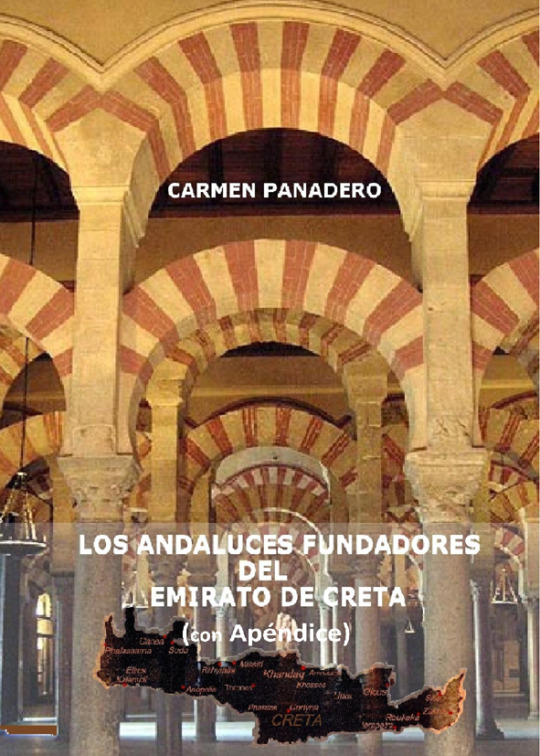
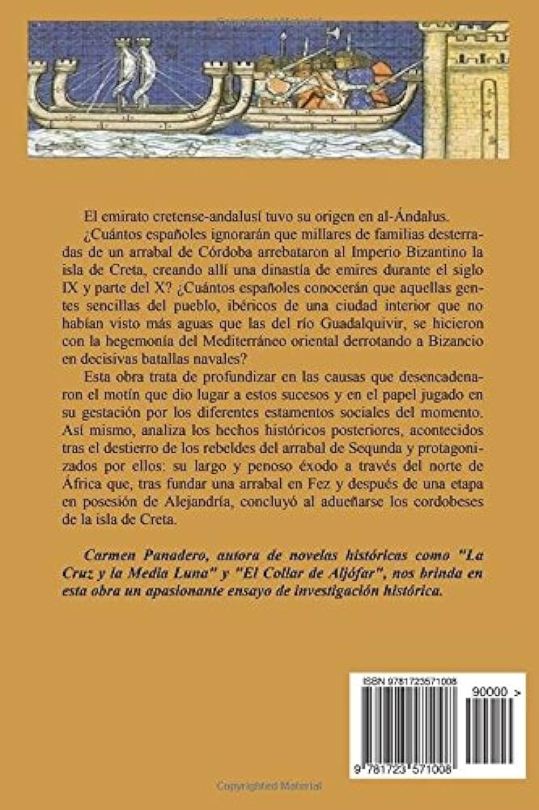
Do we Spaniards know our History? We think we know it. Sometimes important and exciting pages from our historical past appear before our eyes, which we had not heard about. There are many who are unaware, even in Spain, that thousands of families exiled from a suburb of Córdoba took the island of Crete from the Byzantine Empire, creating a dynasty of emirs there during the 9th century and part of the 10th. Very few are those who will know. that those simple people of the town, Iberians from an inland city who had not seen other waters than those of the Guadalquivir River, took over the hegemony of the eastern Mediterranean, defeating Byzantium in decisive naval battles. It all began in Córdoba, in the month of Ramadan 202 of the Hegira (March 818 AD). In this work we try to delve into the causes that caused the mutiny that gave rise to these events and we investigate the role played in it by the different social classes of the moment. Likewise, we analyze the subsequent historical events, triggered by the exile of the rebels from the Sequnda suburb and carried out by them. We will follow the outlawed Cordobans in their long and painful exodus, which, through North Africa and after a period in possession of Alexandria, concluded when they managed to take over the island of Crete. Byzantine and, later, Greek sources have dealt with to the History of the Emirate of Crete and to the people of Cordoba who founded it through manipulation and prejudice, falsifying the historical truth and even calling them pirates. It is inexcusable to finally do them justice, to rehabilitate the figure of their most important leader, Abu Hafs al-Ballutí, and that at least in Spain, his country of origin, it becomes known that the ancient town of Pedroche, his birthplace, and Córdoba, their capital, have many reasons to feel proud of this distinguished character and his lineage. This essay, with rhythm and air of chronicle, has as its main objective to banish the partial and biased vision of this chapter of our History and to make known the true nature of the State founded in Crete by the outlawed Cordobans of the Sequnda suburb. To this end, the author has had to find translators for the fundamental works that document this topic, since they had not even been translated into Spanish until now. Thanks to the Arabic chronicles and, above all, to three Greek historians (Vassilios Christides, Christos Makrypoulias and Nikolaos Panagiotakis), who for the first time faced these historical events, overcoming prejudices and initiating a rectification, we can partly reconstruct the exploits of these Hispanics, Muslims and Christians, in the eastern Mediterranean.
La Estirpe del Arrabal I: Córdoba en el recuerdo (The Arrabal Lineage I: Córdoba in memory), by Carmen Panadero
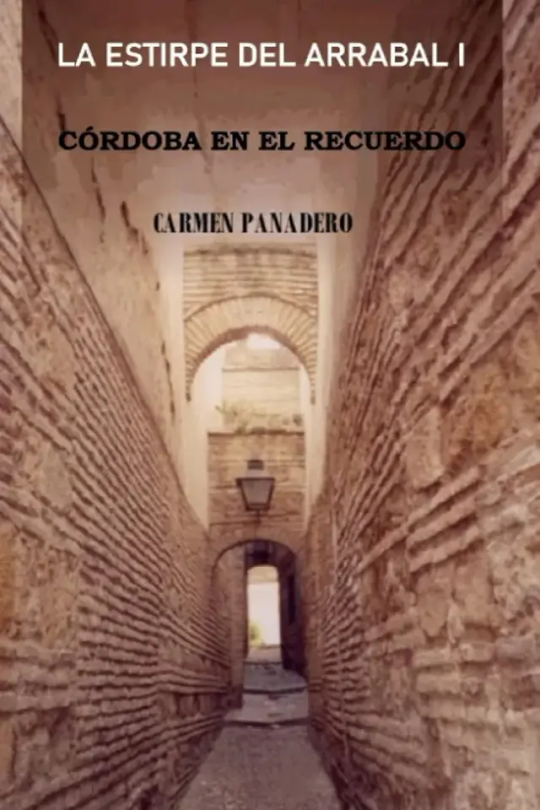
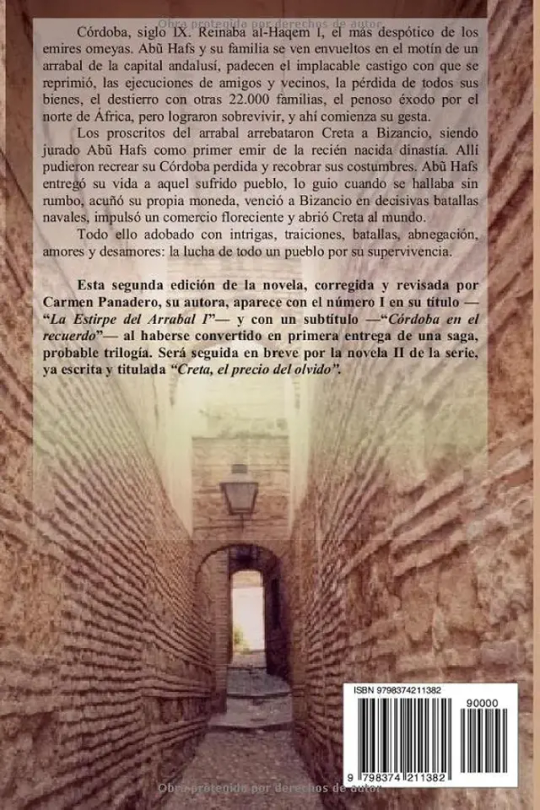
Córdoba, 9th century. Al-Hakam I, the most despotic of the Umayyad emirs, reigned. Abũ Hafs and his family are involved in the riot in a suburb of the Andalusian capital, they suffer the relentless punishment with which it was repressed, the executions of friends and neighbors, the loss of all their property, exile with 22,000 other families, the painful exodus through North Africa, but they managed to survive, and there their adventure begins. The outlaws of the suburb took Crete from Byzantium, and Abũ Hafs was sworn in as the first emir of the newborn dynasty. There they were able to recreate their second Córdoba and recover their customs. Abũ Hafs gave his life to that suffering people, guided them when they were aimless, minted their own currency, promoted flourishing trade, opened Crete to the world and settled the religious conflicts that plagued Byzantium. All of this seasoned with intrigue, betrayal, self-denial, love and heartbreak: the fight of an entire people for its survival.
La Estirpe del Arrabal I: Creta, El Precio del Olvido (The Arrabal Lineage II: Crete, The Price of Oblivion), by Carmen Panadero
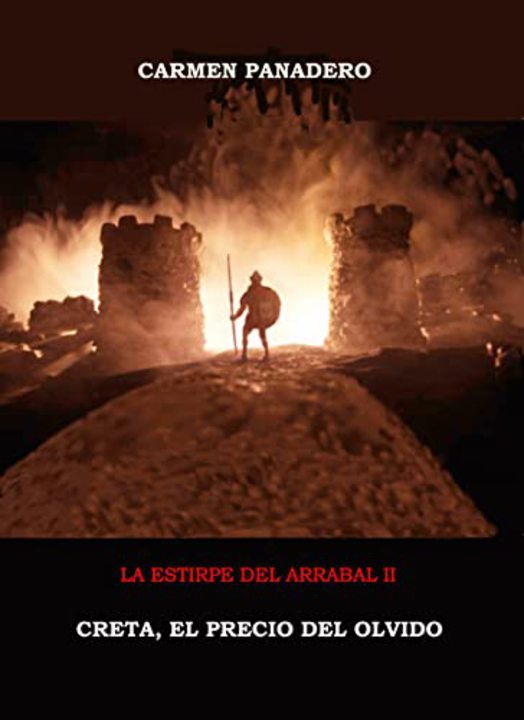
10th century. The crown prince Abd al-Azĩz headed the embassy that arrived in Córdoba sent by his father, the emir of Crete Suhayb II, and when faced with the devastated suburb of Sequnda, from which a century before his ancestors were expelled by the emir al-Hakam I, felt the weight of History and meditated: — “I was never in Córdoba before, why do I feel then as if I had never left?”
But he decided to return to Crete and assume his responsibilities after swearing on those sacred ruins that, on the painful day in which he was to succeed his father, he would choose as his nickname al-Qurtubĩ, "the Cordoban", so that his people would always remember that the Forgetting their past would condemn them to lose Crete like one fateful day they lost Córdoba. And Byzantium lurked.
This novel, the 2nd part of La Estirpe del Arrabal, narrates the events of Abd al-Azĩz I al-Qurtubĩ, the last Andalusian Emir of Crete - his loves, his sorrows, his certain justice, his revenge - and in parallel offers us the touching love stories of his son Al-Numan with Bahã, and of his daughter Yannã with Karim al-Mundhir, the military hero that even Byzantium admired under the Hellenized name of “Karamountes”. And, furthermore, betrayals, intrigues, exploits, battles...
Carmen Panadero, author of novels such as El Collar de Aljófar, La Cruz y la Media Luna or El Halcón de Bobastro, gives us once again that alloy of history and fiction that constitutes the genuine historical novel.
Talking about the Emirate of Crete and the Byzantine Empire, there are some depictions of the battles between them in the Synopsis of Histories, work by the Byzantine historian John Skylitzes from the 11th Century, which covers history from Byzantine Emperors between the death of Nikephoros I in 811 to the deposition of Michael VI in 1057.
Then in the Sicily during the 12th Century, a illuminated manuscript version of Synopsis of Histories was produced at the Norman court of Palermo. This manuscript is called Madrid Skylitzes, because nowadays is housed in the Spanish National Library, in the web page of the Library you can see the Madrid Skylitzes digitized.
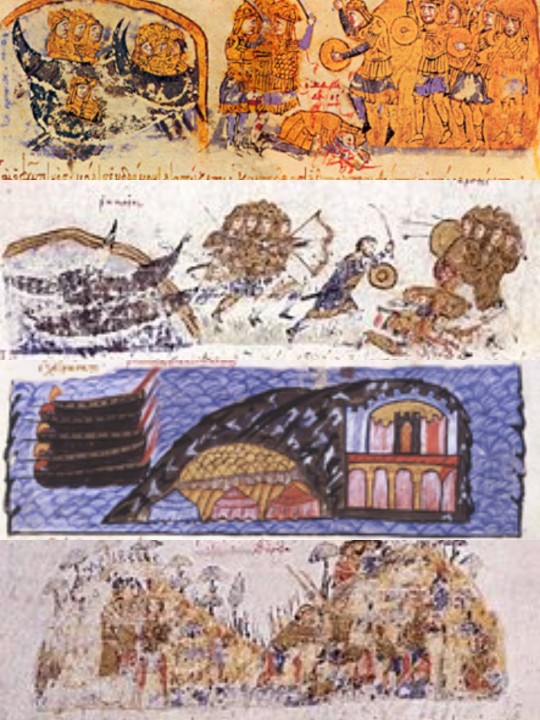
1. Byzantine attack on Crete
2. Byzantines under Krateros defeat the Cretan Saracens
3. Byzantines under Nikephoros Phokas besiege Chandax
4. Byzantines under Ooryphas ambush and defeat the Cretan Saracens
#book scans related#al andalus#emirate of cordoba#emirate of crete#bookblr#books#al andalus history#historical novel#the rabadis#rabadid dinasty#spanish history#la odisea de los rabadíes#la odisea de los rabadíes: el primer exilio hispano#the odyssey of the rabadis: the first hispanic exile#manuel harazem#the odyssey of the rabadies#carmen panadero#los andaluces fundadores del emirato de creta#the andalusian founders of the emirate of crete#la estirpe del arrabal#the arrabal lineage#córdoba en el recuerdo#creta el precio del olvido#greek history#abd al-aziz i of crete#abd al-aziz al-qurtubi#al-balluti#synopsis of histories#john skylitzes
7 notes
·
View notes